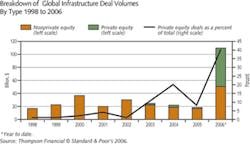The New Water Investors: Infrastructure Funds
by Debra Coy
Utilities and infrastructure used to be boring. Not any more. The global financial markets have “discovered” infrastructure, and this is fast becoming a popular asset class attracting billions of dollars in private investment capital. A recent Standard & Poor’s (S&P) report said that about $100 billion in new money for infrastructure funds was raised globally in 2006, and more new funds are planned for 2007.
Goldman Sachs announced at the end of the year that it had closed a $6.5 billion infrastructure fund, making it the largest single fund of its kind. Other major financial firms that have recently established new infrastructure funds include AIG, Barclays Bank, the Carlyle Group, Deutsche Bank, and Macquarie Bank, as well as several Asian financial groups and GE’s financial services arm. Macquarie is the most experienced player, now managing more than $30 billion in infrastructure assets globally.
The trend is being driven by two key factors, in our view: 1) investors are recognizing the massive need for investment in energy, transportation, water and other forms of infrastructure needed to support economic growth around the world, and 2) aging populations and rising pension investment in North America, Western Europe, and Australia have created demand for the stable, long-term investment returns that basic infrastructure assets can provide.
Ironically, the huge pools of new capital pouring into infrastructure funds in the past two years have made it increasingly difficult to put the money to work. There are currently limited opportunities in toll roads, ports, and water and energy utilities, given government ownership of most of these facilities worldwide.
This has pushed up the valuations of available assets. In the water sector, for example, Macquarie paid £8 billion (US$15.8 billion) to buy Thames Water, the largest UK regulated water utility, a higher-than-expected premium of 20% above Thames’ regulated asset value, as it competed against other potential buyers. Publicly traded water stocks as a group also have continued to outperform the broader financial markets, reflecting investor enthusiasm. Despite the recent market correction, the PowerShares Global Water Portfolio, an exchange-traded fund, is still up 21% from the start of 2006 through early March, compared to a 12% increase for the S&P 500 index.
Though industrial utility assets have thus far received little attention relative to municipal or investor-owned assets, this could begin to change. Firms such as GE and Siemens have offered outsourcing of feedwater and wastewater services for industrial customers for years and are adding more financing into the mix. GE’s Energy Financial Services group, for example, formed a water finance group last year, offering structured equity and customized debt financing for water and wastewater projects, targeting transactions from $15 million to $500 million in size.
Now, with major pools of new capital looking for infrastructure investment opportunities, the idea of spinning off the utility island into a separate financial structure may be worth another look for industrial plant operators.
About the Author: Debra G. Coy is senior research analyst for the water sector for Janney Montgomery Scott LLC, a Philadelphia-based firm that provides political, economic and industry research for institutional and corporate investors. Coy has covered environmental and water industries from Washington, DC, since 1985. This article draws on testimony she gave in January to the U.S. House of Representatives Subcommittee on Water Resources & Environment. Contact: 800-526-6397 or [email protected]

